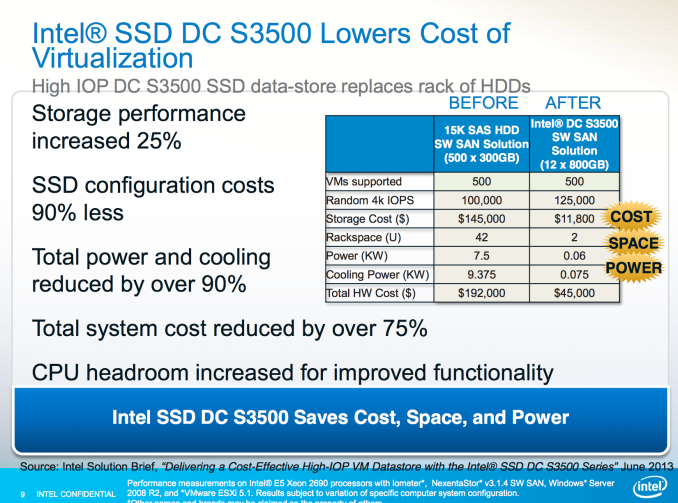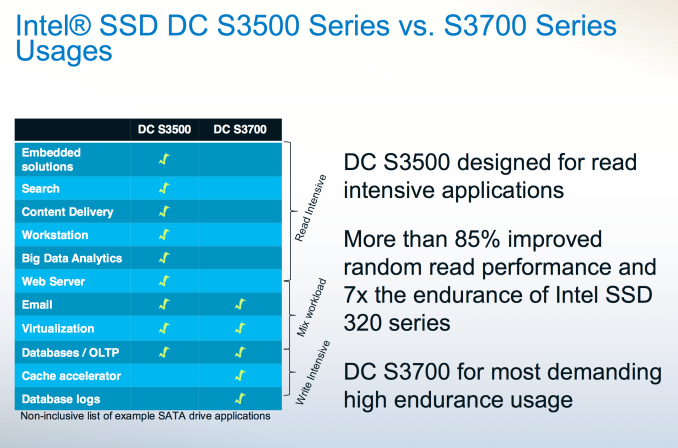Intel SSD DC S3500 Review (480GB): Part 1
by Anand Lal Shimpi on June 11, 2013 6:10 PM EST- Posted in
- Storage
- IT Computing
- SSDs
- Intel
- Datacenter
- Enterprise
Final Words
In our first high level look, Intel's SSD DC S3500 looks to be everything we loved about the S3700 but at a more affordable price point for enterprise customers who don't need insane amounts of write endurance. With SSDs in the enterprise there's this tendency to over estimate endurance needs. I was guilty of it in the design of our SSD requirements for serving AnandTech. Part of the problem is there aren't tons of good software applications to quietly monitor/report/analyze enterprise workload behavior. I suspect that for the vast majority of use cases however, the S3500 is likely more than enough. Even though the AnandTech database servers (content, stats tracking and forums) are fairly write intensive, the S3500 is actually the right target for us - the S3700 would deliver far more endurance than we'd ever use.
Other than write endurance, the only other thing you give up is random write performance. Intel's specs list the S3500 at roughly 1/3 of the sustained 4KB random write performance of the S3700, which I saw in our numbers as well. Given the lower price point however, most customers are likely comparing performance to an array of hard drives. On an individual level, a good high-end HDD will provide somewhere around 1 - 2MB/s in 4KB random write performance. The S3500 by comparison is good for about 40MB/s. Intel's own data shows that 12 S3500s will deliver roughly the same random IO as 500 15K RPM hard drives. Based on the data I've seen, that comparison is pretty accurate.
All of the other S3700 benefits remain. Performance consistency is excellent, which makes the S3500 ideal for use in many-drive RAID arrays. Intel's enterprise drives have typically done very well in terms of reliability as well (and I haven't heard any complaints about the S3700), making the S3500 a safe bet. My only real complaint about this drive is the idle power rating is too high for notebook use, because otherwise I'd even suggest looking at the S3500 for consumer use as well.
All in all I've been pleased with Intel's work in the enterprise SSD space. Most interesting to me is just how aggressive Intel has been in terms of enterprise SSD pricing. The S3500 shows up at well under $1.50/GB, and consumer drives aren't that far off in terms of pricing. Intel typically doesn't push this aggressively for lower prices with its enterprise products, so when it happens I'm very happy.












54 Comments
View All Comments
oyabun - Wednesday, June 12, 2013 - link
I made the same observation, the Samsung has at a minimum the performance of the Intel drive and then skyrockets.cheeselover - Wednesday, June 12, 2013 - link
umm... isn't it the other way around? 600pro already has overprovisioning at 28% and s3500 has it at 9%.btb - Wednesday, June 12, 2013 - link
No Windows 8 Secure boot support?btb - Wednesday, June 12, 2013 - link
oops typo, meant Microsoft eDrive supportlyeoh - Wednesday, June 12, 2013 - link
Anand, do you have IOPs/latency over time graphs for random reads as well? Or are random reads quite stable and we can derive them from the 4KB random read IO meter scores? I notice the sandforce drives seem to find random reads harder, so I'm wondering if there are any latency spikes for various drives.lucasbakker - Wednesday, June 12, 2013 - link
What about Capacitors on this controller? Why is it that nowadays in reviews I don't see any mention anymore about supercapacitors and data loss when losing power.ShieTar - Wednesday, June 12, 2013 - link
Well, those are enterprise drives, Intel probably assumes that their customers will implement their own emergency power plans in their data centers, so the drives itself don't have to.And on consumer drives, the potential data loss of a power outage are rather acceptable for most people. I've personally experienced one real power outage and one blown fuse over the next 25 years, so that's not really a relevant scenario for my PC buying decisions.
lucasbakker - Wednesday, June 12, 2013 - link
It used to be a big issue in reviews. For databases a capacitor can be pretty important, even when taking emergency power setups in mind. Furthermore, I guess that with laptops sudden power drops are a little bit more common.thomas-hrb - Wednesday, June 12, 2013 - link
Somehow I don't see this making it into too many laptops, and enterprise SAN's etc have power failure protection. I think that it is just a feature that was in the S3700 that they did not disable in this unit, it all helps with the prosumer targeting.zanon - Wednesday, June 12, 2013 - link
Um, Anand? Why no mention of your own research showing how key over provisioning was and the immense difference it could make in performance consistency? The S3500 is significantly more expensive then other prosumer drives like the 840 Pro, Corsair Neutron, etc., and by "significant" I mean the magical "25%". That means that someone could instead choose to get another drive (or multiple other drives) and then assign 25% spare area for each, at which point from your own tests it looks like the S3500 gets SLAUGHTERED.Please do not throw softballs to Intel, they are big boys and can and should be expected to produce competitive, top tier stuff with no asterisks. If for some reason the far higher IOPS with better consistency produced by drives like the Corsair aren't worth the same as the Intel drive, please explain why. If there are other special features being factored in, please mention them. But even for a brief, high level overview this didn't feel like it set the proper context. You spent a great deal of time testing and discussing this stuff in the past, so to suddenly have it vanish from the conversation feels pretty weird.